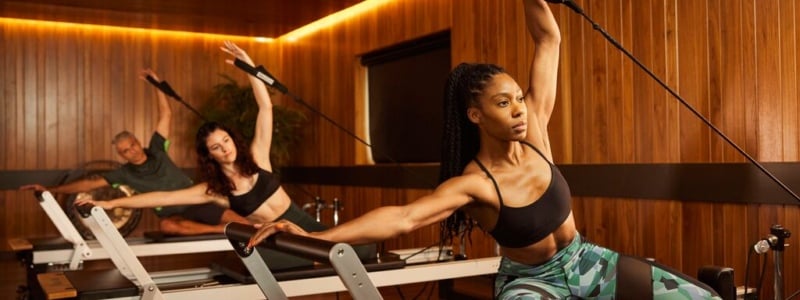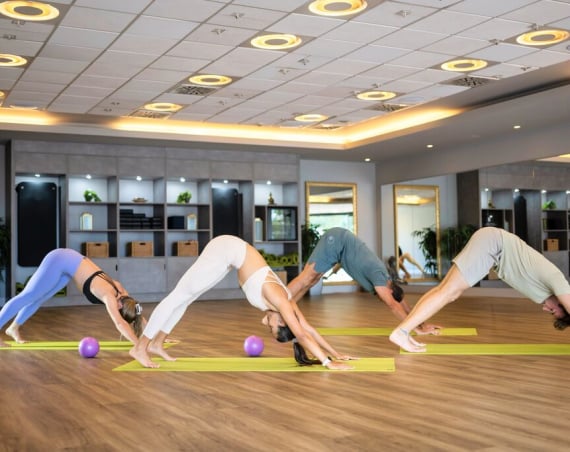The Pilates Reformer was invented by the main man himself, Joseph Pilates, and has since become Pilates’ most distinctive accessory. You’ve likely seen this piece of equipment in various Pilates studios, fitness stores, and even some home setups. It certainly makes a dramatic impression, but that’s not all — it can also have an equally dramatic effect on your workout.
Want to know how to get to grips with the Reformer and give Reformer Pilates a try? Then let’s start by answering some common questions.
What is Reformer Pilates?
Watch our video to take a look at some typical Reformer Pilates moves.
How is Reformer Pilates different from mat Pilates?
As its name suggests, Reformer Pilates is a form of Pilates that uses a specially designed machine called the Reformer. The Reformer consists of a sliding carriage, springs, ropes, a football and, if needed, straps to support your body weight. This unique piece of equipment gives you the option to add resistance to Pilates exercises, making them more challenging than mat Pilates.

Reformer Pilates focuses on building strength, flexibility and balance, while also providing a low-impact, full-body workout.
“Using the resistance of springs increases the strength and endurance workout you get compared to mat Pilates,” explains Jodie Powell, Group Exercise Supervisor at David Lloyd Raynes Park. “It also can provide support to the body to correct technique and get quicker results.”
Is Reformer Pilates suitable for beginners?
Absolutely! Reformer Pilates is suitable for people of all fitness levels, including those who have never done mat Pilates before. The Reformer can be adjusted to accommodate different levels of strength and flexibility, making it an ideal exercise option for beginners. During a typical class, the instructor will guide you through exercises that incorporate upper and lower body strength, as well as core strength.
As a beginner, it’s a good idea to start with one or two Reformer Pilates sessions per week. This will give your body time to adapt to the new exercises and allow you to build strength and flexibility progressively. As you become more comfortable with the Reformer and notice improvements in your fitness, you can increase the frequency of your sessions to three or more times per week.
Do you have to be fit to do Reformer Pilates?
Not at all. The adjustable resistance provided by the Reformer ensures that you can tailor the workout to your current fitness level. As you progress, you can increase the resistance and challenge yourself further. Reformer Pilates is a fantastic way to build and maintain fitness, regardless of your starting point.
“Reformer classes are suitable for all fitness levels,” says Jodie. “We do recommend if you have never done a reformer class or mat Pilates class that you attend a Reformer taster class to ensure you understand the foundations of Pilates and the Reformer bed.”
What are the benefits of Reformer Pilates?
You’ll be doing many of the same exercises as in a mat Pilates class, but the key difference is the Reformer, which allows you to level up your workout and maximise results.
Jodie explains: “The benefits differ [compared to mat Pilates] due to the spring resistance on the bed and being able to perform the exercises in a variety of different ways.
“This leads to the muscles strengthening and re-aligning, which gives you a leaner physique faster than mat Pilates.”
Improved strength
The Reformer’s resistance helps you build muscular strength and endurance, particularly in your core, legs and upper body.
Increased flexibility
Reformer Pilates encourages a greater range of motion, helping you become more flexible and agile over time.
Better balance and coordination
The exercises performed on the Reformer challenge your balance and coordination, leading to improved overall body control.
Enhanced posture
By strengthening your core muscles and improving your body awareness, Reformer Pilates can contribute to better posture and alignment.
Low-impact exercise
Reformer Pilates provides a low-impact workout, making it gentle on your joints while still offering a challenging and effective workout.
How do you prepare for your first class?
To prepare for your first Reformer Pilates class, make sure you wear comfortable, fitted clothing, hydrate and eat a light snack an hour before class and arrive 15 minutes early to get acquainted. During the class itself, listen to your body and communicate with your instructor if you need extra support or advice. Remember that mastering a new form of exercise takes time and practice, so enjoy the process and don’t be discouraged if you don’t excel right away!
As Jodie mentioned, you may also want to try a taster session before your first proper Reformer Pilates class. These sessions provide an opportunity to familiarise yourself with the Reformer machine and learn the basics of the exercises.

Reformer Pilates at David Lloyd Clubs
We’re always looking for new ways to help our members achieve their fitness goals. That’s why we’re excited to have Reformer Pilates within our line-up of classes. If you’re new to Pilates or have only tried mat Pilates before, Reformer Pilates is the perfect opportunity to elevate your practice and experience the transformative effects on your body and mind.
Interested in giving it a try? Reformer Pilates is already offered at many David Lloyd Clubs and will be rolled out to more. Simply find your local Club to learn if Reformer Pilates is available.
Find a club



